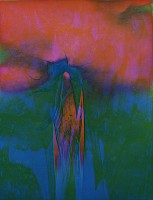BIOGRAPHY

1909-1986
Henry Holmes Smith was an innovative photographer and an influential writer and teacher. He was instrumental in establishing the photography program for László Moholy-Nagy at the New Bauhaus in 1937 and went on to teach for 30 years at Indiana University where he founded the second degree program in photography.
In 1946 Smith began making Light Study photographs, which evolved from the assignment he gave his students at The New Bauhaus. He used wood, paper, reflective and refractive objects to intercept and transform light from a projector. He was inspired by Francis Bruguière’s cut paper work. The studies were initially made in black and white and Smith printed some of them as dye-transfer prints, at times layering multiple images.
Later, Smith also took thick pieces of glass plate and drew on them with light and dark Karo syrup, standing the plates upright so the syrup would run. Next, he would flash sensitized paper with light through the glass and develop the print; if he was happy with the refraction print, he would copy it onto 4 x 5 film. The images often featured anthropomorphic shapes and mythical characters. Smith did not use registration pins when he made dye transfer prints; he used his judgment to place each succeeding matrix. This “free printing” meant that the color layers were slightly displaced, causing the edges to vibrate. As Smith writes: “In my view, the use of color for symbolic ends, however personal, is redemptive. No matter from what or in what way such color is generated, as it functions symbolically, it will let our spirits soar.”
